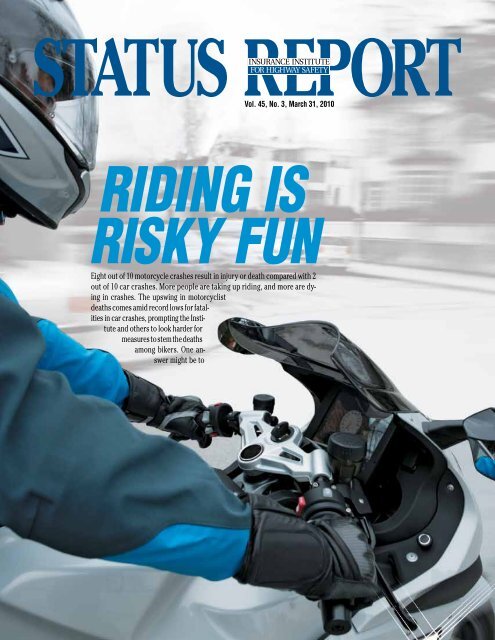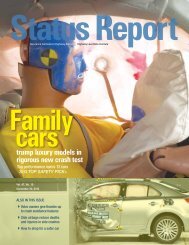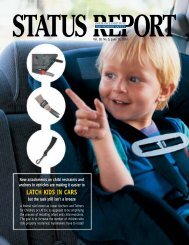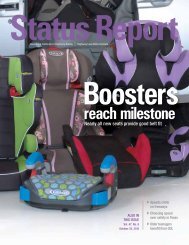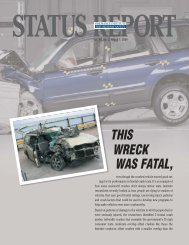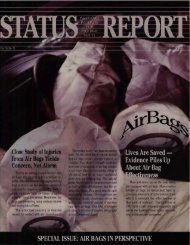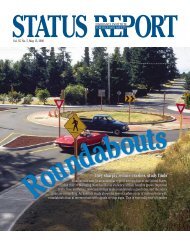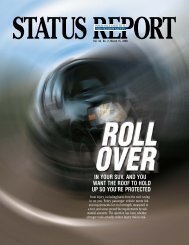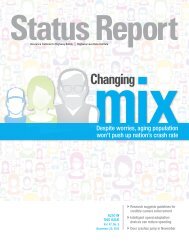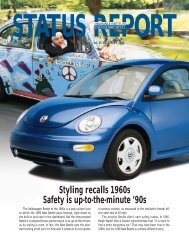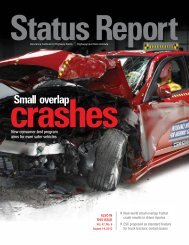IIHS Status Report, Vol. 45, No. 3, March 31, 2010 - Insurance ...
IIHS Status Report, Vol. 45, No. 3, March 31, 2010 - Insurance ...
IIHS Status Report, Vol. 45, No. 3, March 31, 2010 - Insurance ...
- No tags were found...
You also want an ePaper? Increase the reach of your titles
YUMPU automatically turns print PDFs into web optimized ePapers that Google loves.
<strong>Vol</strong>. <strong>45</strong>, <strong>No</strong>. 3, <strong>March</strong> <strong>31</strong>, <strong>2010</strong>riding isrisky funEight out of 10 motorcycle crashes result in injury or death compared with 2out of 10 car crashes. More people are taking up riding, and more are dyingin crashes. The upswing in motorcyclistdeaths comes amid record lows for fatalitiesin car crashes, prompting the Instituteand others to look harder formeasures to stem the deathsamong bikers. One answermight be to
2 <strong>Status</strong> <strong>Report</strong>, <strong>Vol</strong>. <strong>45</strong>, <strong>No</strong>. 3, <strong>March</strong> <strong>31</strong>, <strong>2010</strong>equip more motorcycles with antilock brakes (see p. 6). <strong>Insurance</strong> claims analyses by theHighway Loss Data Institute, an affiliate of the <strong>Insurance</strong> Institute for Highway Safety, underscorethe real-world benefits of helmet laws that apply to all riders (see p. 5) and raise questionsabout the safety benefits of state-mandated training for young riders (see p. 7). First up,though, are the results of a new Institute survey that puts a fresh face on who’s riding today.Rider deaths topped 5,000 in 2008. This is more than in anyyear since the federal government began collecting fatalcrash data in 1975. In contrast, fewer passenger vehicleoccupants died in 2008 crashes than in any year since1975 (national counts for 2009 aren’t available yet).Motorcycle registrations increased to 7.7 million in2008, up from 4.3 million in 2000, according to dataprovided by R. L. Polk and Company.“It’s a troubling trend,” says Anne McCartt, Institutesenior vice president for research. “<strong>No</strong> one wants to begrudgemotorcyclists the opportunity to ride for fun orto get around town on a bike. As the number of new riderscontinues to increase, though, it’s becoming moreimportant than ever to lower the crash risk.”The Institute surveyed 1,818 riders byphone in 2009 to get a picture of nationwidetrends in motorcycling, including respondents’views of helmets, helmet laws, andantilock brakes. Researchers also askedabout travel patterns.Helmet use: The National Highway TrafficSafety Administration estimates that 67percent of motorcyclists in 2009 wore helmetsthat comply with federal safety standards.Seventy-three percent of riders theInstitute surveyed said they always wear ahelmet, and 9 percent said they often wearone. Five percent said they never do.Riders of sport, supersport, and sporttouring bikes were most likely to say theyalways wear a helmet. Riders 18-29 andthose 50 and older were more likely to saythey always ride helmeted, compared withmotorcyclists in their 30s and 40s.What would encourage more bikers to donhelmets? Laws mandating them. Fifty-sevenpercent of respondents who don’t alwayswear helmets said this would convince them.Twenty states and the District of Columbiarequire helmets for all motorcyclists, 27target helmet laws at younger riders, and 3states (Illinois, Iowa, and New Hampshire)have no helmet laws at all. For a rundown,go to iihs.org/laws.About half of the motorcyclistssurveyed said they don’t favor universalhelmet laws, mainly becausethey want to choose for themselves.Still, 76 percent said helmetsmake riders safer. Those 18-29years old were most likelyto say they’d supportuniversal laws, with 54percent in this groupfavoring the mandate.Riders 18-29 also agreedvery stronglythat helmetsenhance safety.Universalhelmet lawsaren’t popular,but they’re effective.Nearly
4 <strong>Status</strong> <strong>Report</strong>, <strong>Vol</strong>. <strong>45</strong>, <strong>No</strong>. 3, <strong>March</strong> <strong>31</strong>, <strong>2010</strong>New Jersey Leadsway with strongteen licensING lawsTeenagers in New Jersey have to wait untilthey’re 17 to get their licenses, and thenthey have to adhere to tough restrictionsdesigned to help improve their driving whileminimizing risks. These policies are payingoff. A new AAA Foundation for Traffic Safetystudy reveals significant reductions in thecrash rates of 17 and 18 year-olds plus eliminationof most crashes of 16 year-olds.Most states license at 16, 16 -1/2, or somewherein between, and a few license evenyounger. Only New Jersey has had a law inplace for decades that puts off licensure until17, which is more in line with policies incountries other than the United States.New Jersey’s graduated licensing program,begun in 2001, puts this state among34 with laws that meet or exceed most Institutebenchmarks for an optimal program exceptthat it notably lacks a nighttime drivingprovision that begins at 9 or 10 pm insteadof later. States with such programs experienceboth lower fatal crash rates among teendrivers and lower rates of insurance claims,compared with states with weaker laws.Only New Jersey applies all of its graduatedlicensing provisions to beginnersyounger than 21. Teens who enter the licensingsystems in nearly every other statebefore they’re 18 graduate from the restrictionsonce they turn 18, and the laws in moststates don’t apply at all to older beginners.Beginners in New Jersey spend at least6 months in the learner’s stage and must be17 to get provisional licenses. Nighttime andpassenger restrictions apply for a year, effectivelymaking 18 the minimum age for anunrestricted license. For people 17-20, boththe learner and provisional stages havenighttime driving restrictions and passengerlimits. Cellphones and other electronicdevices are banned for beginners of all ages,and all occupants must use safety belts.“New Jersey shows that licensing later andand then restricting driving by beginners producessafer drivers who are less prone tocrashing,” says Allan Williams, former Institutechief scientist and lead author of the AAAreport. “Teenagers accrue an extra year ofmaturity before getting behind the wheel andaccumulate on-the-road experience in more favorableconditions. It’s the right combination.”Williams’ study is first to take a comprehensivelook at the combined effects of delayedlicensure and a graduated system thatapplies to all beginners. His research teamcompared crash rates among various agegroups before and after graduated licensingbegan in 2001. Data are from the federalFatality Analysis <strong>Report</strong>ing System and NewJersey records of police-reported crashes.Crash rates among drivers 17 years old,the main beneficiaries of graduated licensing,fell 16 percent in New Jersey after thelaw took effect, relative to crashes of drivers25-59 years old. Fatal crashes per 100,000population declined 25 percent, and injurycrashes per 1,000 population fell 14 percent.Nighttime crashes of 17 year-olds tumbled44 percent, compared with drivers 25-59,after the 2001 law banned beginners fromdriving between midnight and5 am. Before this law,New Jersey ranked<strong>45</strong>th among 51 jurisdictionsin terms of 17year-olds’ fatal crash rates. Afterthe law, the ranking improved to 21st.Williams points out that 15 of the20 states ranking ahead of New Jerseysubject some or all of their 17year-olds to graduated licensing.While other states except Marylanddon’t touch 18 year-olds with driving restrictions,New Jersey’s law benefits driversthis age. The overall crash rate of 18 yearoldsfell 10 percent after the 2001 law. Injurycrashes also fell 10 percent, while crashesamong 16-year-old drivers werelargely eliminated.A concern about postponinglicensure until 17 has beenthat this just delays the riskassociated with beginners,offsetting any safety benefitsof later licensing by elevating17 year-olds’ crash rates, but this hasn’tbeen the case in New Jersey.<strong>No</strong>w the state’s legislators are strengtheningrestrictions on nighttime driving andpassengers. Beginning May 1, the nighttimerestriction will start at 11 pm instead of midnight,and beginners won’t be allowed todrive with passengers other than their dependents.Another new restriction involvesreflective decals on the license plates,both front and rear, of vehicles drivenby people who are younger than 21.The idea is to help police enforcegraduated licensing restrictionsby identifying learners andprovisional licensees.“Evaluation of New Jersey’sGraduated LicensingProgram” by A. F.Williams et al., appearsin the Feb.22, <strong>2010</strong>, issueof Traffic InjuryPrevention.
<strong>Status</strong> <strong>Report</strong>, <strong>Vol</strong>. <strong>45</strong>, <strong>No</strong>. 3, <strong>March</strong> <strong>31</strong>, <strong>2010</strong> 5helmet USE LAWS that APPlyTO ALL RIDERS TRIM LIKELIHOODOF MOTORCYCLE CRASH INJuryMotorcyclists in states that require all riders to wear helmets are lesslikely to file insurance claims for medical treatment after collisions,compared with riders in states without helmet laws or where the lawsapply to some but not all riders. This is the main finding of a newstudy by the Institute-affiliated Highway Loss Data Institute (HLDI).Twenty states require all motorcyclists to wear helmets, 27 targetthe laws at younger riders, and 3 states (Illinois, Iowa, and NewHampshire) don’t have helmet laws at all. HLDI compared the riskof injury claims, given collision claims, for riders in these groups ofstates, finding the lowest risk under the universal laws. Injury risk was3 percent higher in states with laws applying to some riders and 6percent higher in states without helmet laws. Injury risk was 4 percenthigher among riders older than 21 in states where these riders aren’trequired to wear helmets.The study includes collision and medical payment claims data associatedwith 2001-09 model motorcycles involved in crashes in allbut a few states during 2002-09. Collision coverage, which insuresagainst damage to a motorcycle, generally applies when a rider is atfault. Medical payment covers the medical costs of injured riders upto policy limits. Overall, more than half of collision claims resulted inassociated medical payment claims. HLDI’s database doesn’t includeHELMET USE IS VIRTUALLY UNIVERSAL IN STATESTHAT REQUIRE HELMETS ON ALL RIDERS. THE USERATE IS ABOUT 50 PERCENT WITHOUT SUCH LAWS.information about the types of injuries associated with such claims orwhether riders were wearing helmets when they crashed.Helmets are the principal countermeasure for reducing head injuries,the leading cause of death among unhelmeted riders. Theyreduce the likelihood of death by 37 percent. Without them, motorcyclistsare 3 times as likely as helmeted riders to suffer traumaticbrain injuries. Yet many motorcyclists refuse to wear a helmet if it’snot illegal to ride without one.Nearly all riders wear helmets in states with universal laws, but requiringhelmets on some riders doesn’t boost use rates or rider safetynearly as much. Helmet use is about half in states that don’t havehelmet laws or that apply their laws only to younger riders.For a copy of “Helmet use laws and medical payment injury riskfor motorcyclists with collision claims,” write: Publications, HighwayLoss Data Institute, 1005 <strong>No</strong>rth Glebe Rd., Arlington, VA 22201; oremail publications at iihs.org.
6 <strong>Status</strong> <strong>Report</strong>, <strong>Vol</strong>. <strong>45</strong>, <strong>No</strong>. 3, <strong>March</strong> <strong>31</strong>, <strong>2010</strong>642ANTILOCK BRAKESON MOTORCYCLESprevent crashesThe best motorcycle crash is the one thatnever happens. One technology designedto reduce the chance of crashing is antilockbraking. The Institute first reported on theeffectiveness of motorcycle antilocks in2008 (see <strong>Status</strong> <strong>Report</strong>, Oct. 22, 2008; on theweb at iihs.org). <strong>No</strong>w 2 new studies, one bythe Institute and one by the affiliated HighwayLoss Data Institute (HLDI), providemore evidence that antilocks reduce fatalcrash risk and lower insurance losses.Stopping a motorcycle is trickier thanstopping a car. For one thing, the front andrear wheels typically have separate brakecontrols. In an emergency, a rider faces asplit-second choice to either brake hard,fatal crashesper 10,000 motorcycle registratIONS,WITH AND WITHOUT ANTILOCKS, 2003-08withoutantilockswithoutwithantilocks antilockswithantilocks0-10-20ple. But the new studies indicate that antilocksreduce crashes overall and save lives.Institute researchers compared the fatalcrash experience of antilock-equipped motorcyclesagainst their nonantilock counterpartsduring 2003-08. The main findingis that motorcycles with antilocks versuswithout are 37 percent less likely to be infatal crashes per 10,000 registered vehicleyears. Bolstering this finding is a separateHLDI analysis of insurance claims filed fordamage to motorcycles. Bike models withantilocks have 22 percent fewer claims fordamage per insured vehicle year than thesame models without antilocks.Drivers younger than 25 have the highestestimated claim frequencies. Wheremotorcyclists ride also affects claims. Thefrequency of claims for crash damage tobikes is 9 percent higher in urban areas withheavy traffic than in moderately congestedinsurance claimspercent reductIONS in collISION lOSSesfor 2003-08 MODelS with antilocks0-10-20claimfrequencyclaimfrequency severityoverall claimseverity losseswhich can lock the wheels and cause anoverturn, or hold back on braking and riskrunning headlong into the emergency. This iswhen antilocks can help by reducing brakepressure when they detect impending lockupand then increasing the pressure again whentraction is restored. Brake pressure is evaluatedmultiple times per second, so ridersmay brake fully without fear of locking up.Antilocks won’t prevent every motorcyclecrash. They won’t help a rider who’sabout to be struck from behind, for examlocales.There were 13 percent fewer claimsin the least populated areas than in mediumdensity ones. The effects of antilocks onclaims were estimated only after controllingfor these and other factors.Antilocks are gaining traction among motorcyclemanufacturers and wider acceptanceamong riders. More than half of motorcycleowners recently surveyed by the Institutesaid they’d get antilocks on their next bike.Buyers can find them now on at least 60 newmodels (go to iihs.org for a list).overalllosses“Motorcycle antilocks do make a difference,”says Institute president Adrian Lund,who also is president of HLDI. “They helpmake traveling on 2 wheels less risky by reducingthe chance of overturning a bike andcrashing. Passenger vehicles still are safer,but if you’re going to ride we’d recommendgetting a motorcycle with antilocks.”HLDI also looked at injury claims.Under medical paymentcoverage, motorcycleswith antilocksregistered 30 percentlower claim frequenciesthan bikeswithout this feature.Claim frequencies were33 percent lower underbodily injury liabilitycoverage.Institute researchersused data from the federalFatality Analysis<strong>Report</strong>ing System and motorcycleregistration recordsfrom R. L. Polk andCompany. HLDI provided antilockfeature informationfrom its proprietary databaseof vehicle features.For a copy of “Effectivenessof antilockbraking systems inreducing motorcyclefatal crashrates” by E.R.Teoh or a HLDIspecial reporton motorcycleantilockbraking systems,write:Publications,<strong>Insurance</strong> Institutefor HighwaySafety, 1005<strong>No</strong>rth Glebe Rd.,Arlington,VA22201; or emailpublications@iihs.org.
<strong>Status</strong> <strong>Report</strong>, <strong>Vol</strong>. <strong>45</strong>, <strong>No</strong>. 3, <strong>March</strong> <strong>31</strong>, <strong>2010</strong> 7TRAINING FAILS TOreduce crash riskOF young ridersIn many US states, youngbeginners have to take atraining course beforethey become eligiblefor a licenseto drive a motorcycle.“Motorcycling requires unique skills,and training probably is the right way formost riders to learn them,” says AdrianLund, president of both HLDI and the affiliated<strong>Insurance</strong> Institute for Highway Safety.“Just don’t count on it to reduce crashes orsubstitute for laws requiring helmet use.”The analysis looks at collision losses in4 states (California, Florida, Idaho, and Oregon)that require rider education for licenseapplicants younger than 21, compared withlosses in 28 states without training requirements.The study doesn’t include data from13 states that require training for ridersyounger than 18 plus 1 state that mandatesit for riders younger than 16 becausesample sizes are too small.For a copy of “Motorcycle collisioncoverage claims in states with requiredmotorcycle rider training,”write: Publications, Highway LossData Institute, 1005 <strong>No</strong>rth GlebeRd., Arlington, VA 22201; or emailpublications at iihs.org.The intent is to reduce crashes,but a new analysis of insuranceclaims indicates the opposite may be true.Researchers at the Highway Loss Data Institute (HLDI)analyzed motorcycle claims under collision coverage to see if crashrisk is lower in states that require training for riders younger than 21, comparedwith states that don’t require any training. The main finding is that the frequencyof insurance collision claims for riders this age is 10 percent higher, not lower, wheretraining is required. Although this difference isn’t statistically significant, it contradictsthe notion that motorcycle training courses reduce crashes. A potential explanation is thatriders in some states are fully licensed once they finish training. This might shorten the permitperiod so that riders end up with full licenses earlier than if training weren’t mandated.DON’T COUNT ONmotorcycleTRAINING COURSESTO REDUCE CRASHESOR TO substitute forLAWS REQuiring allriders TO Wear helmets.insurance claims formotorcycle crash damageare filed more freQuentlyIN states that REQuirecomPletion OF trainingcourses before becomingELIGIBLE FOR A LICENSE TODRIVE A MOTORCYCLE.
1005 N. Glebe Rd., Arlington, VA 22201Phone 703/247-1500 Fax 247-1588Internet: www.iihs.org<strong>Vol</strong>. <strong>45</strong>, <strong>No</strong>. 3, <strong>March</strong> <strong>31</strong>, <strong>2010</strong>Survey of motorcyclists focuses on travelpatterns, crash involvement, helmet use,and other aspects of cycling and safety .......1New Jersey cuts beginners’ crash riskwith combination of older licensing age andrestrictions on all beginners..........................4Wearing a helmet reduces injuries, basedon analysis of insurance claims for medicalcosts ..........................................................5Motorcycle antilocks are safety pluses ......6Mandatory training courses for motorcyclistsdon’t reduce crashes ............................7Contents may be republished with attribution.This publication is printed on recycled paper.The <strong>Insurance</strong> Institute for Highway Safety is anonprofit scientific and educational organizationdedicated to reducing deaths, injuries, and propertydamage from crashes on the nation’s highways.The Institute is wholly supported by auto insurers:AAA Mid-Atlantic <strong>Insurance</strong> GroupAAA <strong>No</strong>rthern California, Nevada, and UtahAffirmative <strong>Insurance</strong>Agency <strong>Insurance</strong> Company of MarylandAlfa Alliance <strong>Insurance</strong> CorporationAlfa <strong>Insurance</strong>Allstate <strong>Insurance</strong> GroupAmerican Family Mutual <strong>Insurance</strong>American National Property and Casualty CompanyAmeriprise Auto & HomeAmica Mutual <strong>Insurance</strong> CompanyAuto Club EnterprisesAuto Club GroupAuto Club South <strong>Insurance</strong> CompanyBituminous <strong>Insurance</strong> CompaniesBristol West <strong>Insurance</strong> GroupBrotherhood Mutual <strong>Insurance</strong> CompanyCalifornia CasualtyCapital <strong>Insurance</strong> GroupChubb & SonColorado Farm Bureau Mutual insurance CompanyConcord Group <strong>Insurance</strong> CompaniesCotton States <strong>Insurance</strong>COUNTRY FinancialDiscovery <strong>Insurance</strong> CompanyErie <strong>Insurance</strong> GroupEsuranceFarm Bureau Financial ServicesFarm Bureau Mutual <strong>Insurance</strong> Company of IdahoFarmers <strong>Insurance</strong> Group of CompaniesFarmers Mutual of NebraskaFireman’s Fund <strong>Insurance</strong> CompanyFirst Acceptance CorporationFlorida Farm Bureau <strong>Insurance</strong> CompaniesFrankenmuth <strong>Insurance</strong>Gainsco <strong>Insurance</strong>GEICO GroupGeorgia Farm Bureau Mutual <strong>Insurance</strong> CompanyGMAC <strong>Insurance</strong>Grange <strong>Insurance</strong>Hanover <strong>Insurance</strong> GroupThe HartfordHaulers <strong>Insurance</strong> Company, Inc.High Point <strong>Insurance</strong> GroupHomeowners of America <strong>Insurance</strong> CompanyICW GroupKemper, A Unitrin BusinessKentucky Farm Bureau <strong>Insurance</strong>Liberty MutualLouisiana Farm Bureau Mutual <strong>Insurance</strong> CompanyMarkel CorporationMercury <strong>Insurance</strong> GroupMetLife Auto & HomeFarm Bureau <strong>Insurance</strong> of MichiganMichigan <strong>Insurance</strong> CompanyMiddleOakMississippi Farm Bureau Casualty <strong>Insurance</strong> CompanyMMG <strong>Insurance</strong>Mutual of Enumclaw <strong>Insurance</strong> CompanyNationwideNew Jersey Manufacturers <strong>Insurance</strong> CompanyNLC <strong>Insurance</strong> Companies, Inc.<strong>No</strong>dak Mutual <strong>Insurance</strong> Company<strong>No</strong>rfolk & Dedham Group<strong>No</strong>rth Carolina Farm Bureau Mutual <strong>Insurance</strong> CompanyOklahoma Farm Bureau Mutual <strong>Insurance</strong> CompanyOld American County Mutual Fire <strong>Insurance</strong>OneBeacon <strong>Insurance</strong>Oregon Mutual <strong>Insurance</strong>Palisades <strong>Insurance</strong>Pekin <strong>Insurance</strong>PEMCO <strong>Insurance</strong>Progressive CorporationRockingham GroupSafeco <strong>Insurance</strong>Samsung Fire & Marine <strong>Insurance</strong> CompanySECURA <strong>Insurance</strong>Sentry <strong>Insurance</strong>Shelter <strong>Insurance</strong>Sompo Japan <strong>Insurance</strong> Company of AmericaSouth Carolina Farm Bureau Mutual <strong>Insurance</strong> CompanySouthern Farm Bureau Casualty <strong>Insurance</strong> CompanyState Auto <strong>Insurance</strong> CompaniesState FarmTennessee Farmers Mutual <strong>Insurance</strong> CompanyTokio Marine NichidoThe Travelers CompaniesUnitrinUSAAVirginia Farm Bureau Mutual <strong>Insurance</strong>West Bend Mutual <strong>Insurance</strong> CompanyZurich <strong>No</strong>rth AmericaFUNDING ASSOCIATIONSAmerican <strong>Insurance</strong> AssociationNational Association of Mutual <strong>Insurance</strong> CompaniesProperty Casualty Insurers Association of America


